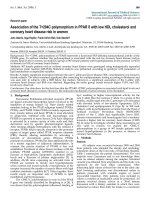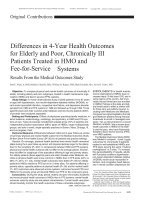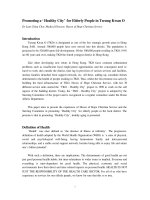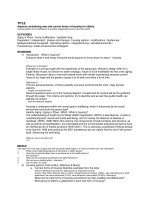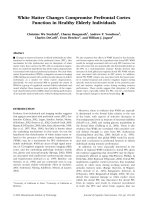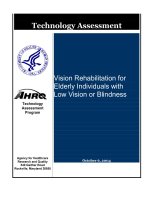Vision Rehabilitation for Elderly Individuals with Low Vision or Blindness pot
Bạn đang xem bản rút gọn của tài liệu. Xem và tải ngay bản đầy đủ của tài liệu tại đây (2.19 MB, 257 trang )
Technology Assessment
Technology
Assessment
Program
Agency for Healthcare
Research and Quality
540 Gaither Road
Rockville, Maryland 20850
Vision Rehabilitation for
Elderly Individuals with
Low Vision or Blindness
October 6, 2004
TABLE OF CONTENTS
Table of Contents i
Estimate of Number of Individuals in Elderly Medicare
Population who Might Benefit from Vision Rehabilitation
Training and Credentialing of Vision Rehabilitation
State Statutory and Regulatory Requirements for Unlicensed
Tables v
Tables (Appendix B) vi
Table (Appendix C) vi
Tables (Appendix D) vi
Table (Appendix F) vii
Tables (Appendix G) vii
Figure viii
Figure (Appendix E) viii
Executive Summary 1
Scope of Report 17
Background 20
Low Vision and Blindness 20
Definitions of Low Vision and Blindness 20
Causes of Low Vision and Blindness 23
Consequences of Low Vision or Blindness 25
Services 25
Vision Rehabilitation Services 36
Personnel 37
Vision Rehabilitation Personnel 46
Page i
Clinical Practice Guidelines 46
Patient Evaluation 49
Management and Rehabilitation 51
Referral and Multidisciplinary Care 52
Follow-up Care 53
Ongoing Trials 53
Methods 53
Key Question, Analytic Framework, and Outcomes 53
Key Question Addressed 54
Analytic Framework for Addressing Effectiveness of Vision
Rehabilitation 54
Outcomes Assessed 55
Literature Searches 59
Inclusion/Exclusion Criteria 59
Data Extraction 63
Evaluation of the Quality of Evidence Base 64
Statistical Methods 64
Evidence Base 64
Evidence Synthesis 66
Comprehensive Services 67
Quality of Included Studies 67
Details of Study Enrollees and Study Generalizability 68
Details of Programs Evaluated 69
Outcomes Assessed 73
Findings of Included studies 74
Findings of other Systematic Reviews 79
Subsection Summary 79
Page ii
Optical Aids and Low-Vision Devices 81
Quality of Included Studies 81
Details of Study Enrollees and Study Generalizability 82
Outcomes Assessed 84
Findings of Included Studies 84
Findings of Systematic Reviews 87
Subsection Summary 89
Orientation and Mobility Training 90
Quality of Included Studies 90
Details of Study Enrollees and Study Generalizability 91
Details of Programs Evaluated 91
Outcomes Assessed 93
Findings of Included Studies 94
Findings of Systematic Reviews 96
Subsection Summary 96
Adaptive Techniques Training 98
Quality of Included Study 98
Details of Study Enrollees and Study Generalizability 98
Details of Program Evaluated 99
Outcomes Assessed 99
Findings of Included Studies 99
Findings of Systematic Reviews 100
Subsection Summary 101
Group Intervention Programs 101
Quality of Included Studies 102
Details of Study Enrollees and Study Generalizability 103
Details of Programs Evaluated 103
Outcomes Assessed 105
Page iii
Findings of Included Studies 106
Findings of Systematic Reviews 108
Subsection Summary 108
Supervision of Services and Outcome 109
Bibliography 113
APPENDICES: Supporting Documentation and Evidence Tables . 131
Appendix A. Full Text of Medicare Program Memorandum
(29
th
May 2002) 132
Appendix B. Education and Certification of Non-Medicare
Physician Vision Rehabilitation Personnel 136
Occupational Therapists 137
Physical Therapists 143
Low-Vision Therapist 148
Orientation and Mobility Specialists 161
Rehabilitation Teacher 168
Appendix C. Ongoing Trials 176
Appendix D. Outcome Measures 184
Appendix E. Literature Searches 191
Electronic Database Searches 192
Hand Searches of Journal and Nonjournal Literature 196
Appendix F. Excluded Studies 197
Appendix G. Evidence Tables 200
Page iv
TABLES
Table 1. ICD-9-CM Definitions of Low Vision and Blindness 20
Table 2. Primary Causes of Low Vision in the Elderly 24
Table 3. State-by-State Low Vision and Blindness Prevalence
Estimates 30
Table 4. Evidence Base 65
Table 5. Types of Vision Rehabilitation Services Evaluated 66
Table 6. Quality of Studies of Comprehensive Vision
Rehabilitation Services 67
Table 7. Outcomes Assessed 73
Table 8. Quality of Studies of Low-Vision Devices and
Optical Aids 82
Table 9. Outcomes Assessed 84
Table 10. Systematic Reviews of Optical Aids and
Low-Vision Devices 88
Table 11. Quality of Studies of Orientation and Mobility Training 91
Table 12. Outcomes Assessed 93
Table 13. Quality of Studies of Adaptive Techniques Training 98
Table 14. Quality of Studies of Group Intervention Programs 102
Table 15. Outcomes Assessed 105
Table 16. Rehabilitation Services Supervision and Personnel 109
Page v
TABLES (APPENDIX B)
Table B-1. Typical Curriculum of a Degree Course in
Occupational Therapy 137
Table B-2. Typical Curriculum of a Degree Course in
Physical Therapy 143
Table B-3. Pennsylvania College of Optometry Low-Vision
Therapy Certificate and Master’s Program Courses 148
Table B-4. Typical Curriculum of an O&M Specialist Degree
Course 161
Table B-5. Typical Curriculum of Rehabilitation Teacher
Degree Program 168
TABLE (APPENDIX C)
Table C-1. Ongoing Trials 176
TABLES (APPENDIX D)
Table D-1. Instruments used to Evaluate Activities of Daily
Living 184
Table D-2. Instruments used to Evaluate Mood
Table D-3. Instruments used to Evaluate Psychosocial
188
Functioning 189
Table D-4. Instruments used to Evaluate Quality of Life 190
Page vi
TABLE (APPENDIX F)
Table F-1. Excluded Studies 197
TABLES (APPENDIX G)
Table G-1. Systematic Reviews and Technology Assessments 200
Table G-2. Study Design Details 202
Table G-3. Study Design Characteristics Pertaining to Internal
Validity 206
Table G-4. Patient Enrollment Criteria 211
Table G-5. Characteristics of Enrolled Patients I:
Residential Status and Underlying Pathology 214
Table G-6. Characteristics of Enrolled Patients II
(Demographics) 218
Table G-7. Charactersics of Enrolled Patients III
(Comorbidities) 224
Table G-8. Rehabilitation Program Details 228
Table G-9. Study Findings 240
Page vii
FIGURE
Figure 1. Analytic Framework for Addressing Effectiveness of
Vision Rehabilitation 55
FIGURE (APPENDIX E)
Figure E-1. Study Selection Algorithm 191
Page viii
EXECUTIVE SUMMARY
Section 645 (a) of the Medicare Prescription Drug, Improvement and
Modernization Act of 2003 requires that the Secretary of Health and
Human Services conduct a study to determine the feasibility and
advisability of providing payment for vision rehabilitation services
furnished by vision rehabilitation professionals.(1) The Secretary has
been instructed to report on this study and provide recommendations
for such legislation or administrative action as the Secretary
determines to be appropriate.
On February 10
th
2004, AHRQ issued a Statement of Work (SOW)
contracting ECRI to update a previous report published in
October 2002 titled, “Vision Rehabilitation: Care and Benefit Plan
Models.”(2) The SOW specified that ECRI should update and extend
the Lewin Group report by systematically reviewing new evidence on
the potential of vision rehabilitation services to improve the quality of
life and functioning of the elderly with low vision or blindness. In
commissioning this report, AHRQ provided ECRI with four Specific
Aims. These Specific Aims are as follows:
1. Estimate the number of elderly persons with vision loss that might
benefit from vision rehabilitation services. Review published
estimates if available. If not, use sources of data such as the
National Health Interview Survey or other sources as appropriate.
Discuss how available data on prevalence relate to studied
indications on vision rehabilitation and estimate how many
Medicare beneficiaries might benefit from vision rehabilitation.
Page 1
2. Update the Lewin report by reviewing any additional information
regarding the training of vision rehabilitation personnel in the
United States, as well as any practice guidelines or other
documentation regarding accepted practice. Provide a summary of
organizations that provide training and credentialing of vision
rehabilitation professionals. Provide a summary of different state
statutory or regulatory requirements governing both the
credentialing of providers and the provision of services.
3. Update the Lewin report by systematically reviewing new evidence
on the effectiveness of vision rehabilitation services. Include
information on:
a. The types of providers and settings that were used in studies
b. The components and frequency of vision rehabilitation
services provided in the studies
c. The patient population that was studied, including age,
whether community dwelling or in nursing homes, and
information about the extent and characteristics of vision
loss
d. Validity of the outcomes selected for measurement
e. Methods of measurement of outcomes
f. Outcomes of the vision rehabilitation services
g. The possible role of the pattern of vision loss, the etiology of
vision loss, and the prognosis for an individual patient’s
future vision on the benefits of vision rehabilitation
Page 2
4. Summarize the types of providers that provided the services in the
clinical trials, whether the services were provided under physician
supervision, and the outcomes achieved. Provide an analysis of
how these results might be generalizable to the question of
whether providers, specifically the three types of providers
specified in the law (low-vision therapists, orientation and mobility
specialists, and rehabilitation teachers), can provide quality
services in the absence of physician supervision.
The findings of our assessment as they pertain to these four Specific
Aims are presented below.
Specific Aim 1: The precise number of individuals in the U.S.
Medicare population who might benefit from vision rehabilitation
services is not known; only estimates are available. Despite a number
of limitations, the best estimate currently available emanates from a
model developed by Massof.(3) Massof’s model was developed using
data from five U.S. population-based prevalence studies that
screened for visual impairment (the Beaver Dam Study,(4) the
Baltimore Eye Survey,(5-7) the Framingham Eye Study,(8-10) the
Mud Creek Valley Study,(11) and the Salisbury Eye Evaluation
Study.(12))
Massof’s model, when applied to census data collected for the year
2000, estimates that approximately 1.255 million individuals in the
U.S. consisting of 1,120,000 whites and 135,000 blacks would meet
the ICD-9-CM definition for low vision (ICD-9 codes beginning with
Page 3
the prefix 369.xx
1
) and are thus potential candidates for vision
rehabilitation services. This represents approximately 3.7% and 4.9%
of the total white and black Medicare-aged population, respectively.
These prevalence estimates include individuals with visual
impairment from potentially correctable cataracts. Vision loss due to
cataracts can, in most cases, be surgically corrected. Consequently,
the prevalence estimates need to be adjusted to account for these
individuals. Although the precise number of individuals with
correctable cataract cannot be determined, Massof estimated this
figure to lie in the region of 15% to 20%.(13) Assuming that this
estimate is reasonable, we calculated that the total number of
individuals in the U.S. who might be considered as potential
candidates for low-vision rehabilitation services falls within the range
of 1,004,000 to 1,066,750. Thus, adjusting for the prevalence of
cataracts, we estimate that approximately 3.3% to 3.5% of Medicare-
aged whites (896,000 to 952,000 individuals) and 3.8% to 4.1% of
Medicare-aged blacks (108,000 to 114,750 individuals) are potential
candidates for low-vision rehabilitation services.
Although Massof’s model provides the best currently available
estimates of the prevalence of low vision among the elderly Medicare
population, the generalizability of these estimates to the specific
question, “How many Medicare beneficiaries might benefit from vision
1
ICD-9 codes for “low vision” are coded 369.XX, where the prefix 369 relates to the diagnosis of “low
vision or blindness” and the suffix .XX relates to the severity of the low vision in both eyes.
Page 4
rehabilitation services?” cannot be determined. There are several
reasons for this:
• First, the prevalence estimates calculated using Massof’s
model were based on data from epidemiological studies that
were not designed to determine the prevalence of individuals
who meet Medicare’s current eligibility criteria for vision
rehabilitation services. Rather, these studies were designed to
provide an estimate of the prevalence of visual impairment in
selected U.S. populations where the definition of visual
impairment was usually based solely on measures of visual
acuity. Disability resulting from visual impairment is not entirely
dependent upon visual acuity. Visual field loss and other
impairments can also lead to disability. For the purposes of
addressing Specific Aim 1 then, available data on the
prevalence of visual impairment will likely underestimate the
true prevalence of low vision in the U.S.
• Second, Medicare’s current suggested medical necessity
criteria for vision rehabilitation services extend beyond the
World Health Organization (WHO) definitions of low vision
(ICD-9-CM code: 369.xx) and include individuals with a number
of uncorrectable and irreversible visual field defects that fall into
the ICD-9 diagnostic category of a “visual disturbance” (ICD-9-
CM code: 368.4x). Massof’s prevalence estimates do not take
into account this latter diagnostic category. The consequence of
this is that, even if prevalence data from the population-based
studies listed above were to provide an accurate estimate of the
Page 5
prevalence of low vision, the estimates emanating from
Massof’s model will likely underestimate the true prevalence of
low vision as defined by Medicare’s eligibility criteria.
• Third, the studies used to develop Massof’s model focused
primarily on white populations. Although two of the studies did
evaluate African Americans, none evaluated any other racial
groups. Consequently, the generalizability of the estimates
derived from the Massof model to the elderly Medicare
population is unclear.
Specific Aim 2: Vision rehabilitation services are multidisciplinary.
Although staffing models differ from program to program, guidelines
from the American Academy of Ophthalmology (AAO)(14) and the
American Optometric Association (AOA)(15) list both licensed
medical personnel (ophthalmologists, optometrists, ophthalmic
nurses, occupational therapists and physical therapists) and
unlicensed low-vision professionals (low-vision therapists, vision
rehabilitation teachers, and orientation and mobility specialists) as
appropriate providers of vision rehabilitation services.
The Lewin Group report provided little information on the training and
credentialing of personnel that provide vision rehabilitation services.
In the present report, we provide descriptions of each service
provider considered by the AAO and the AOA to be members of a
multidisciplinary rehabilitation team. We also provide details of their
training and credentialing. In particular, we provide extensive
information on the training and credentialing that is available to
Page 6
selected vision rehabilitation personnel who do not meet the current
definition of a Medicare physician (occupational therapists, physical
therapists, low-vision therapists, rehabilitation teachers, and
orientation and mobility trainers).
Information on state statutory or regulatory requirements governing
both the credentialing of providers and the provision of services is
sparse. Ophthalmologists, optometrists, occupational therapists,
physical therapists, and social workers are all required to be licensed
by the states in which they practice. There are currently no state
statutory or regulatory requirements governing the provision of vision
rehabilitation services by unlicensed personnel (low-vision therapists,
rehabilitation teachers, or orientation and mobility specialists). Efforts
supported by a number of organizations are currently underway in the
state of New York to obtain licensure for low-vision therapists, vision
rehabilitation teachers, and orientation and mobility specialists as a
new class of allied health professional.(16-18) To date, however, this
and other similar efforts in the states of North Dakota and Tennessee,
have not been successful.(16,17,19)
Low-vision therapists, rehabilitation teachers, and orientation and
mobility specialists can, provided they meet certain eligibility criteria,
apply for certification by the Academy for Certification of Vision
Rehabilitation and Education Professionals (ACVREP). According to
the National Vision Rehabilitation Cooperative, ACVREP certification
of unlicensed vision rehabilitation personnel is recognized by many
states as a “…strong barometer to ensure quality control among
Page 7
providers.”(20) For example, the state of Alabama strongly
encourages that unlicensed vision rehabilitation personnel within its
programs have ACVREP certification and the state of Georgia
requires ACVREP certification for rehabilitation teachers and
orientation and mobility specialists that work in state-run
programs.(20)
Specific Aim 3: In order to address Specific Aim 3, we asked the
following Key Question: Is vision rehabilitation an effective
intervention for patients with irreversible low vision or blindness?
In assessing effectiveness, we considered four outcomes related to
disability and function; activities of daily living, mood, psychosocial
status, and quality of life.
Since the publication of the Lewin Group report, the field of vision
rehabilitation has been active, funding opportunities for research into
low vision have improved, and a plethora of new studies are
underway. This increase in activity, however, is not yet mirrored by
the literature. Our literature searches, which were limited to the period
January 2000 to February 2004,
2
identified a total of five systematic
reviews(21-25) and 13 studies that met our a priori inclusion
criteria.(26-38) These studies included four RCTs,(26-29)
two nonrandomized controlled trials,(30,31) and seven before-after
studies.(32-38)
2
The Lewin Group report covered literature published before this time. As per the requirements of Task 3,
this report focuses on new evidence that has been published since the publication of the Lewin Group
report.
Page 8
The quality of each included study was rated using standard criteria
as proposed by the U.S. Preventive Services Task Force
(USPSTF).(39) The quality of included studies was not high. No
included studies, not even the RCTs, were completely protected from
all potential confounders. Three RCTs were rated as USPSTF
Level I-Low,(27-29) one RCT was rated as Level I-Fair,(26)
one non-randomized controlled trial was rated as Level II-1-Fair,(30)
one non-randomized controlled trial was rated as Level II-1-Low,(31)
six before-after-studies were rated as Level II-3-Fair,(33-38) and
one before-after-study was rated as Level II-3-Low.(32) This finding is
in concordance with the findings of the Lewin Group report and
five other systematic reviews that have been published since
2000.(21-25)
The generalizability of each included study to the elderly Medicare
population was estimated from study enrollment criteria and the
reported characteristics of the patients who were actually enrolled in
the study. With the exception of one study,(38) which was excluded
from our analysis for reasons of poor generalizability, the
generalizability of the findings of the included studies to the elderly
Medicare population were judged to be “Fair.”
The included studies evaluated the effectiveness of several different
vision rehabilitation services. These included comprehensive
rehabilitation services,(32,35,37) optical aids and low-vision
devices,(28-30,33,38) orientation and mobility training,(31,34) training
in the use of adaptive techniques (eccentric viewing),(36) and group
intervention programs.(26,27)
Page 9
Comprehensive Vision Rehabilitation Programs
One systematic review published since January 2000 assessed the
effectiveness of comprehensive rehabilitation programs. Stelmack et
al.(24) concluded that exposure to vision rehabilitation services leads
to improvements in self-reported functional status and quality of life.
This conclusion, however, was based on data from a small evidence
base consisting of four studies.
Our searches identified three studies published since January 2000
that evaluated the effectiveness of three different comprehensive
vision rehabilitation programs and met the a priori inclusion criteria for
this assessment.(32,35,37) All three studies utilized a before-after
design (one study: USPSTF Quality Rating: Level II-3-Low;
two studies: USPSTF Quality Rating: II-3-Fair). The results of these
studies, though methodologically weak, suggest that individuals with
low vision do benefit from exposure to comprehensive vision
rehabilitation services.
One cannot draw evidence-based conclusions pertaining to the
relative effectiveness of the three comprehensive vision rehabilitation
service models evaluated, or draw conclusions about the relative
effectiveness of different staffing models. The available evidence
does not allow one to determine the relative effectiveness of the
different components of the programs assessed or determine the
optimal frequency and intensity of service provision. Finally, evidence
from included studies does not allow one to draw conclusions
pertaining to the relationship between the pattern of vision loss, the
Page 10
etiology of vision loss, and the prognosis for an individual patient’s
future vision following exposure to comprehensive vision
rehabilitation services.
Optical Devices and Visual Aids
Three relevant systematic reviews have been published since
January 2000.(21-23) Of these, one evaluated evidence on the
effectiveness of an array of optical devices and low-vision aids that
are used in VA vision rehabilitation programs,(21) one evaluated the
effectiveness of optical filters,(23) and the third evaluated evidence
on the effectiveness of an implantable miniature telescope.(22)
All three systematic reviews failed to reach any evidence-based
conclusions because of a paucity of available data.
Our searches identified five studies published since January 2000
that evaluated the effectiveness of optical aids or low-vision devices
and met the a priori inclusion criteria for this assessment.(28-
30,33,38) One of these studies was excluded from further
consideration because of poor generalizability to the Medicare
population.(38) The remaining studies were small (N ranged from 22
to 90), fair-to-low quality (USPSTF Quality Ratings ranged from I-Low
to II-3-Fair), laboratory-based studies.(28-30,33)
All four included studies showed that the prescription of optical
devices and low-vision aids improved reading performance. One
included study examined the question of the optimum number of
training sessions required following prescription of low-vision
aids.(28) This study found that five training sessions, followed by
Page 11
practice, was optimal. Because all four studies were directly
supervised and performed by optometrists, one is precluded from
drawing conclusions about how different supervisory and staffing
models may influence outcome.
Orientation and Mobility Training
One systematic review published since January 2000 attempted to
evaluate the effectiveness of orientation and mobility training. Virgili
and Rubin(25) searched the Cochrane Central Register of Controlled
Trials Medline, Embase, and LILACS up to September 2002 for
randomized and quasi-randomized controlled trials. No randomized
or quasi-randomized controlled trials were identified by their searches
so no conclusions about the effectiveness of orientation and mobility
training were drawn.
Evidence on the effectiveness of orientation and mobility from two
studies(31,34) that met the a priori inclusion criteria for this
assessment is inconclusive. One non-randomized controlled study
(USPSTF Quality Rating: II-1-Fair) did not provide evidence
supporting the hypothesis that orientation and mobility training leads
to improvements in mobility.(31) The other study, which utilized a
before-after study design (USPSTF Quality Rating: II-3-Fair), found
that exposure to an orientation and mobility-based program resulted
in a number of improvements across a number of domains of
psychosocial status.(34) Whether the differences in the findings of the
two included studies are the result of differences in study quality,
Page 12
differences in service protocol, differences in enrolled patients, or
differences in the outcomes measured is not known.
In summary, the effectiveness (or lack of effectiveness) of orientation
and mobility training has yet to be demonstrated by a well-designed
study that has utilized validated instruments to measure a patient-
oriented outcome. In addition, the available data does not allow one
to draw evidence-based conclusions regarding the relative
effectiveness of different orientation and mobility training programs or
the optimal frequency and intensity of administration of such services.
Nor does the available evidence allow one to draw conclusions
regarding the relationship between the pattern of vision loss, the
etiology of vision loss, and the prognosis for an individual patient’s
future vision following exposure to orientation and mobility training
programs.
Adaptive Techniques Training
Our searches identified one before-after study (USPSTF Quality
Rating: II-3-Fair) that evaluated the effectiveness of adaptive
techniques training and met the a priori inclusion criteria for this
assessment.(36) This Swedish study used a computer program in
conjunction with a scanning laser ophthalmoscope (SLO) to teach
individuals with age-related macular degeneration (AMD) to use
eccentric retinal loci for reading. The study investigators found that 18
of 20 enrolled individuals learned to use eccentric viewing for the
purposes of reading. Among these 18 individuals, reading speeds
increased significantly from baseline (p <0.001). Because no long-
Page 13
term followup data are available, however, it is not clear whether
these improvements in reading performance can be maintained over
time.
Available data does not allow one to draw evidence-based
conclusions regarding the relative effectiveness of different adaptive
training techniques. Nor does the available evidence allow one to
draw conclusions regarding either the optimal frequency and intensity
of administration of eccentric viewing training, or the relationship
between the pattern of vision loss, the etiology of vision loss, and the
prognosis for an individual patient’s future vision following exposure
to the program.
Group Intervention Programs
The Lewin Group report identified four studies that evaluated the
effectiveness of group intervention programs. Based on the findings
of these studies, the Lewin Group report stated that group
intervention “…appears to be effective, based on attitudinal outcomes
and perceptions of activity levels.”(2)
Our searches identified two relevant articles describing two RCTs that
were published since January 2000 and met the a priori inclusion
criteria for this assessment.(26,27) One of these articles presented
updated data emanating from a RCT that was cited in the Lewin
Group report.(27) These updated data, along with data from the
remaining RCT, lend support to the conclusions of the Lewin Group
report. Both studies found that exposure to a group intervention
program led to significant improvements in patient outcomes. Brody
Page 14
et al. (USPSTF Quality Rating: I-Fair) found that quality of life and
mood among individuals with low vision (all enrollees had AMD) who
had been exposed to their self-management group intervention
program were significantly improved when compared to controls.(26)
Dahlin Ivanoff et al. (USPSTF Quality Rating: I-Low) found that
exposure to their group health education program led to significant
improvements across a number of activities of daily living.
Available data does not allow one to draw evidence-based
conclusions regarding the relative effectiveness of the two group
intervention programs, the optimal frequency and intensity of these
programs, or the most effective staffing model. Nor does the evidence
allow one to draw evidence-based conclusions regarding the
relationship between the pattern of vision loss, the etiology of vision
loss, and the prognosis for an individual patient’s future vision
following exposure to group intervention programs.
Specific Aim 4: The personnel that provided services in the studies
that are included in this report covered the entire gamut of vision
rehabilitation personnel identified previously. Rehabilitation services
described by the included studies were usually (11 out of 13 studies)
directly supervised by a Medicare-defined physician.
3
Because of limitations in the literature, it is not possible to provide an
analysis of how the outcomes of the included studies might be
3
Relevant Medicare-defined physicians who include doctors of medicine; doctors of osteopathy; and
doctors of optometry; see Appendix A and CMS Medical Benefit Policy Manual (189)
Page 15
generalizable to the question of whether providers, specifically the
three types of providers specified in the law (low-vision therapists,
orientation and mobility specialists, and rehabilitation teachers),
can provide quality services in the absence of direct physician
supervision.
The only direct evidence, albeit weak, to demonstrate that quality
services can be provided by low-vision therapists, orientation and
mobility specialists, and rehabilitation teachers in the absence of
direct physician supervision comes from two before-after-studies
(USPSTF Quality Ratings: II-3-Fair and II-3-Low) both of which
evaluated the effectiveness of the Veterans Affairs Blind
Rehabilitation Centers program.(32,37) Although Medicare-defined
physicians are involved in this rehabilitation program (they are
responsible for the clinical management of enrolled individuals and
are members of the rehabilitation team that develops an
individualized care plan for new enrollees), they do not supervise the
implementation of vision rehabilitation services directly. The
implementation of the care plan is instead coordinated by a
rehabilitation specialist (orientation and mobility specialists, vision
rehabilitation teachers, and low-vision therapists). Both De l’Aune et
al.(32) and Stelmack et al.(37) demonstrated that exposure to this
service improves the ability of “blind” veterans to perform activities of
daily living, which in turn enhances their quality of life.
Page 16
